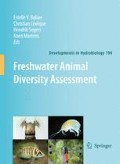Abstract
Among the 10,000 birds species living on earth, 5% (e.g., 560) need imperatively freshwater habitat in order to satisfy at least one of their life history traits. About 11 completed families could even disappear if their wetland habitat left. About 10% (58) of these can be considered as endemic. Africa contains the biggest number of endemic (20) and more precisely Madagascar. Among freshwater species, ducks and geese have a major importance in human activities in northern hemisphere related to food resources (hunting) or birding.
Access this chapter
Tax calculation will be finalised at checkout
Purchases are for personal use only
Preview
Unable to display preview. Download preview PDF.
References
American Ornithological Union, 1998. The American Ornithologists’ Union Check-list of North American Birds, 7th edn. Washington, D.C.
Ash, R. W., 1969. Plsasma osmolality and salt gland secretion in the duck. Quarterly Journal of Experimental Physiology 54: 68–79.
Birdlife international, 2000. Threatened birds of the world. Barcelona and Cambridge. UK. Lynx Edicions and Birdlife International.
Clements, J. F., 2000. Birds of The World: A Checklist. 5th edn. Ibis Publishing, Vista, California.
Del Hoyo J., A. Elliott & J. Sargatal (eds), 1992. Handbook of the birds of the world, Vol. 1. Lynx Edicions, Barcelona.
Devillers, P., H. Ouellet, E. Benito-Espinal, R. Beudels, R. Cruon, N. David, C. Érard, M. Gosselin & G. Seutin, 1993. Noms français des oiseaux du Monde. MultiMonde et Chabaud Éd. MultiMondes Inc., Sainte-Foy, Québec & Éd. Chabaud, Bayonne, France.
Hebert, P. D. N., M. Y. Stoeckle, T. S. Zemlak & C. M. Francis, 2004a, Identification of Birds Through DNA Barcodes. PLoS Biology 2: 1657–1663.
Hebert, P. D. N., E. H. Penton, J. M. Burns, D. H. Janzen & W. Hallwachs, 2004b. Ten species in one: DNA barcoding reveals cryptic species in the.neotropical skipper butterfly Astraptes fulgerator. PNAS 101: 14812–14817.
Howard, R. & L. Moore, 2003. The Howard & Moore Complete Checklist of the Birds of the World. Princeton University Press.
Kalchreuter, H., 1996. Waterfowl harvest and population dynamics: an overview. Gibier Faune Sauvage—Game and wildlife 13: 991–1008.
Kress, W. J., K. J. Wurdack, E. A. Zimmer, L. A. Weigt & D. H. Janzen, 2005. Use of DNA barcodes to identify flowering plants. Proceedings of National Academy of Sciences 02: 8369–8374.
Long, P. R., T. Székely, M. Kershaw & M. O’Connell, 2007. Ecological factors and human threats both drive wildfowl populations decline. Animal conservation 10: 183–191.
Mooij, J. H., 2005. Protection and use of waterbirds in the European union. Beiträge zur Jagd und Wildforschung 30:49–76.
Roux, F., P. Jouventin, J. F. Mougin, E. Stahl & H. Weimerskirch, 1983. Un nouvel albatros Diomedea amsterdamensis découvert sur l’ile Amsterdam (37°50′ S, 77°35′ E). Oiseau Rev Fr Orn 53: 1–11.
Sibley, C. G. & J. E. Ahlquist, 1990. Phylogeny and Classification of Birds. New Haven, Conn.: Yale University Press.
Sibley, C. G. & B. L. Monroe, 1991, Distribution and Taxonomy of Birds of the World. Yale University Press, New Haven and London.
van Rootselaar, O., 1999. New birds for the World: species discovered during 1980–1999 Birding World 12: 286–293.
van Rootselaar, O, 2002. New birds for the World: species described during 1999–2002 Birding World 15: 428–431.
Xu, X., Z. Zhou, X. Wang, X. Kuang, F. Zhang & X. Du 2003, Four-Winged Dinosaurs from China. Nature 421: 335–340.
Author information
Authors and Affiliations
Corresponding author
Editor information
Editors and Affiliations
Rights and permissions
Copyright information
© 2007 Springer Science+Business Media B.V.
About this chapter
Cite this chapter
Dehorter, O., Guillemain, M. (2007). Global diversity of freshwater birds (Aves). In: Balian, E.V., Lévêque, C., Segers, H., Martens, K. (eds) Freshwater Animal Diversity Assessment. Developments in Hydrobiology, vol 198. Springer, Dordrecht. https://doi.org/10.1007/978-1-4020-8259-7_60
Download citation
DOI: https://doi.org/10.1007/978-1-4020-8259-7_60
Publisher Name: Springer, Dordrecht
Print ISBN: 978-1-4020-8258-0
Online ISBN: 978-1-4020-8259-7
eBook Packages: Biomedical and Life SciencesBiomedical and Life Sciences (R0)

